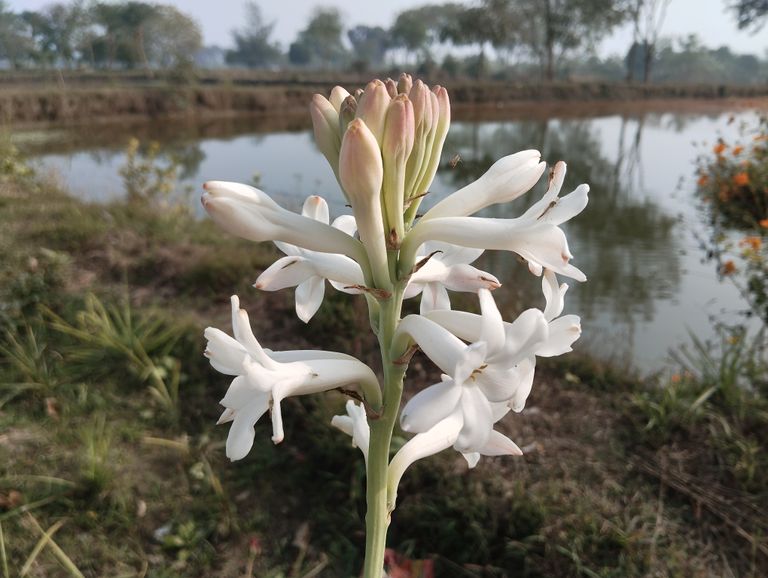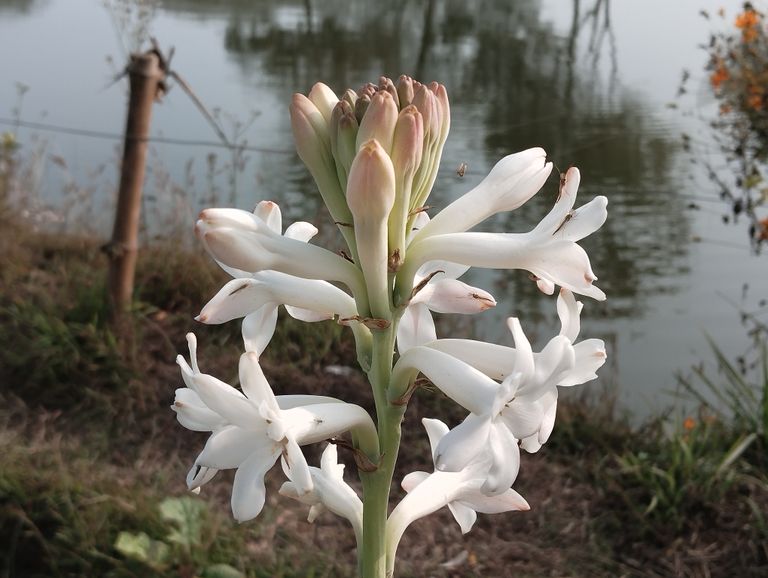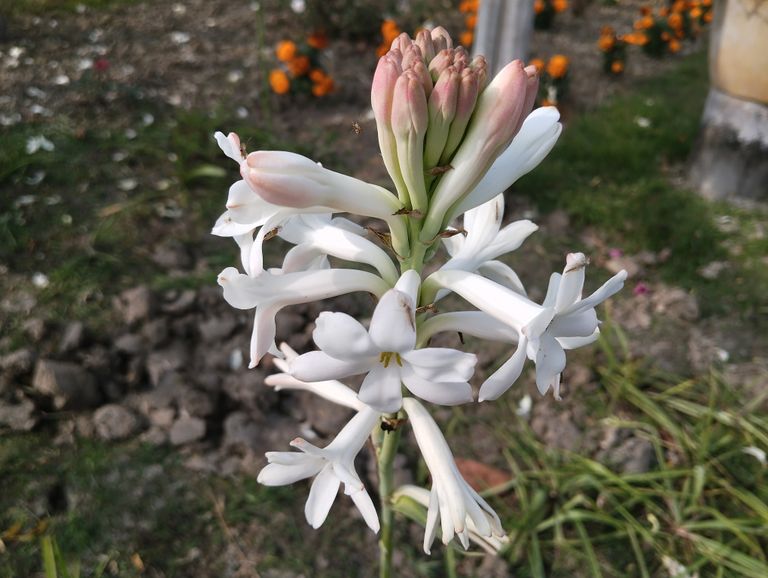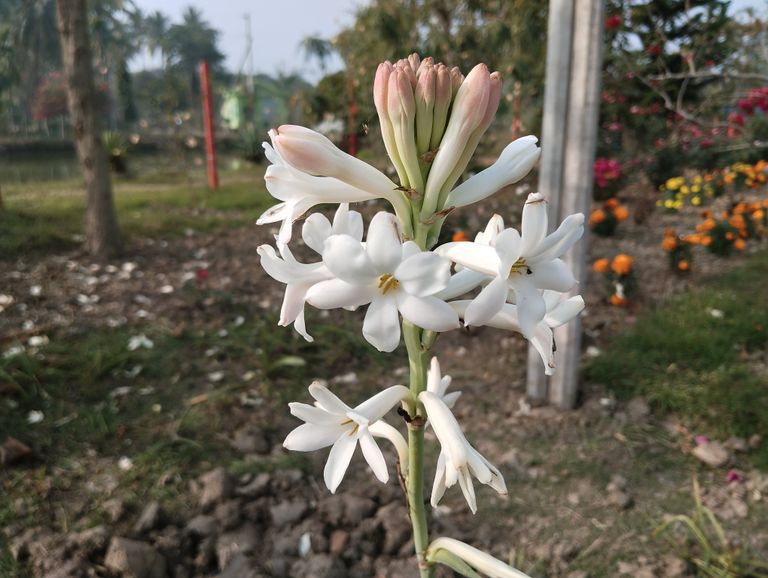
The Beauty of Rajanigandha Capturing the Elegance of Tuberose through Photography.
Tuberose, commonly known as Rajanigandha in South Asia, is a flower renowned for its enchanting fragrance and pure white beauty. This delicate bloom has inspired poets, artists, and photographers for centuries. In this blog, we will explore the art of photographing Rajanigandha, delving into its aesthetic appeal and providing tips for capturing its essence through your lens.
The Allure of Rajanigandha
Rajanigandha flowers are symbolic of purity, serenity, and elegance. Known for their sweet, intoxicating aroma, they are often used in weddings, religious ceremonies, and perfumery. The long, slender stems with clusters of pristine white blossoms make them an exquisite subject for photography. Their minimalistic beauty is both timeless and universally appealing, making them a favorite for photographers seeking to capture nature’s simplicity.
Why Photograph Rajanigandha?
Unique Structure: The elongated stems and tightly clustered buds create an interesting visual dynamic.
Play of Light and Shadow: The white petals reflect light beautifully, offering opportunities to experiment with lighting techniques.
Cultural Significance: Capturing Rajanigandha can evoke nostalgia and emotions tied to traditions and festivities.
Versatility: These flowers look stunning in various settings, whether in natural gardens or as part of an artistic arrangement.
Tips for Rajanigandha Photography
- Choose the Right Lighting
Lighting is crucial in flower photography, especially when working with white flowers like Rajanigandha.
Natural Light: Early morning or late afternoon provides soft, diffused light, which enhances the flower’s natural beauty without harsh shadows.
Artificial Light: Use a softbox or diffuser to avoid overexposure and retain the delicate details of the petals.
- Experiment with Backgrounds
Rajanigandha’s white hue can stand out beautifully against contrasting backgrounds.
Dark Backgrounds: Highlight the flower’s purity by placing it against black or dark green for a dramatic effect.
Soft Pastels: A pastel background can create a dreamy and romantic vibe.
- Focus on Details
Zoom in to capture the intricate details of the petals and buds. Use a macro lens to bring out textures, veins, and subtle color variations.
- Play with Angles
Experiment with different angles to showcase the flower's structure.
Close-Up Shots: Highlight the blossoms and their arrangement.
Side Profiles: Showcase the stem's elegance and the buds’ linear formation.
Top Views: Focus on the symmetrical arrangement of petals.
- Incorporate Water Drops
Spraying a fine mist of water on the petals can add a fresh, dewy effect to your shots. The droplets also act as tiny lenses, reflecting light and adding depth to your composition.
- Use Props and Arrangements
Enhance your photography by incorporating props:
Place Rajanigandha in a clear glass vase for minimalistic beauty.
Pair it with candles or soft fabrics to create an artistic composition.
Capture the flower in its natural habitat, surrounded by greenery.
Post-Processing for Rajanigandha Photography
Post-processing can elevate your photographs by enhancing the flower’s natural beauty.
Adjust Brightness and Contrast: Ensure the whites are not overexposed.
Enhance Colors: Slightly boost the green of the stem and leaves to complement the white blossoms.
Add Soft Filters: Use subtle filters to give your image a dreamy or vintage look.
Telling a Story through Rajanigandha Photography
Photographing Rajanigandha is more than capturing its physical beauty—it’s about telling a story. Whether you focus on a single flower swaying in the breeze or a bouquet adorning a traditional ceremony, your photos can evoke emotions and celebrate the flower’s timeless charm.
Rajanigandha is a flower that transcends cultural and geographical boundaries with its elegance and fragrance. Capturing its beauty through photography is a rewarding experience, allowing you to appreciate its simplicity and sophistication. Whether you’re an amateur photographer or a seasoned professional, the tips in this blog can help you showcase the allure of Rajanigandha in all its glory.

The Beauty of Rajanigandha Flowers
The Rajanigandha flower, often referred to as the "Tuberose" in English, is one of nature's most enchanting creations. Known for its delicate appearance and heavenly fragrance, this flower holds a special place in the hearts of flower enthusiasts worldwide. Whether gracing a garden, adorning a bouquet, or being used in spiritual ceremonies, the Rajanigandha’s allure is truly timeless. In this blog, we will explore the exquisite beauty, cultural significance, and uses of this captivating flower.
The Alluring Appearance
The Rajanigandha flower is admired for its slender white petals, which cluster together to form a stunning visual. Each flower stalk grows tall and upright, carrying multiple blooms that exude elegance. Its pristine white hue symbolizes purity, peace, and simplicity, making it a favorite choice for decorations and floral arrangements.
One of the most striking features of the Rajanigandha is its ability to thrive both during the day and night. Its name, "Rajanigandha," is derived from two Sanskrit words: "Rajan" (night) and "Gandha" (fragrance), which together mean "the fragrance of the night." True to its name, the flower releases its intoxicating scent as the sun sets, captivating anyone nearby.
Cultural and Traditional Significance
Rajanigandha flowers hold deep cultural and traditional importance in many regions of the world, especially in South Asia. In countries like India, Bangladesh, and Sri Lanka, the flower is associated with auspicious events, spirituality, and love. Here are some notable cultural connections:
- Weddings and Celebrations
The Rajanigandha is a popular choice for wedding decorations, garlands, and bouquets. Its pure white color is seen as a symbol of new beginnings and eternal love. The flowers are often used in bridal jewelry, such as hair adornments, enhancing the bride’s elegance.
- Religious Ceremonies
In Hindu and Buddhist traditions, Rajanigandha flowers are offered to deities during prayers and rituals. Their fragrance is believed to purify the surroundings and elevate the spiritual atmosphere.
- Aromatic Symbol of Love
In many cultures, the flower is associated with romance and passion. Its enchanting scent is thought to evoke feelings of love and nostalgia, making it a popular gift for loved ones.
Uses of Rajanigandha Flowers
The beauty of Rajanigandha flowers extends beyond their visual appeal. They have various uses in different domains, including:
- Perfume and Aromatherapy
The Rajanigandha's fragrance is rich, sweet, and long-lasting, making it a prized ingredient in the perfume industry. Essential oils derived from the flower are also used in aromatherapy to reduce stress, promote relaxation, and enhance mood.
- Floral Decorations
The flower’s versatility makes it a top choice for decorative purposes. From weddings to festive occasions, Rajanigandha flowers are used to create garlands, flower walls, and table centerpieces.
- Medicinal Properties
In traditional medicine, Rajanigandha flowers are believed to have therapeutic benefits. Their extracts are used in some remedies to calm the mind, alleviate anxiety, and improve sleep quality.
- Cosmetic Applications
The flower’s essence is used in skincare and beauty products for its soothing properties and delightful fragrance.
Growing and Caring for Rajanigandha
If you’re captivated by the beauty of Rajanigandha, why not grow it in your own garden? The flower thrives in warm climates and requires well-drained soil and plenty of sunlight. Here are some tips for cultivating this beautiful plant:
Planting: Use healthy bulbs and plant them in a sunny location. Make sure the soil is rich in organic matter.
Watering: Keep the soil moist but avoid overwatering, as it may cause the bulbs to rot.
Fertilizing: Use a balanced fertilizer every few weeks to promote healthy growth and blooming.
Pest Control: Keep an eye out for pests like aphids or mites, which can damage the plant.
With proper care, the Rajanigandha will reward you with its delicate blooms and captivating scent.
Symbolism and Emotional Impact
The Rajanigandha flower is not just a feast for the senses; it also carries deep symbolic meanings. It represents purity, devotion, and everlasting love, making it a popular choice for expressing emotions. Its scent is often described as nostalgic, capable of transporting people to cherished memories and serene moments.
The Rajanigandha flower is a true masterpiece of nature. Its pristine beauty, intoxicating fragrance, and cultural significance make it a flower that is cherished by all. Whether you admire it in a garden, wear it as an accessory, or use it to enhance your surroundings, the Rajanigandha never fails to leave a lasting impression. Embrace the timeless elegance of this extraordinary flower, and let its charm fill your life with beauty and serenity.

How to Cultivate Rajanigandha (Tuberose): A Comprehensive Guide
Tuberose, popularly known as Rajanigandha in Bengali, is a fragrant flower that holds immense economic value due to its use in the floral and perfume industries. Its captivating fragrance and ornamental appeal make it a favorite for farmers and gardeners alike. Here is a detailed guide on how to cultivate Rajanigandha effectively.
- Climate and Soil Requirements
Climate:
Tuberose thrives in a tropical and subtropical climate. It requires warm temperatures ranging from 20°C to 30°C. Excessive cold or frost conditions can hinder its growth.
Soil:
Well-drained loamy or sandy loam soil with a pH of 6.5–7.5 is ideal. The soil should be rich in organic matter. Avoid waterlogged areas, as tuberose bulbs are susceptible to rot.
- Varieties of Rajanigandha
Popular varieties of tuberose include:
Single-flowered varieties: Popular for their stronger fragrance and used in perfume production.
Double-flowered varieties: Preferred for ornamental purposes and flower arrangements.
- Land Preparation
Plow the field thoroughly 3–4 times to achieve a fine tilth.
Remove weeds and mix well-rotted compost or organic manure (about 20–25 tons per hectare).
Add fertilizers like urea, superphosphate, and potash to enhance soil fertility.
- Planting Process
Planting Season:
The ideal time for planting is February to April. However, in some areas, it can also be planted during the monsoon season.
Planting Material:
Use healthy, disease-free bulbs with a diameter of 1.5–2.5 cm.
Planting Method:
Plant the bulbs at a depth of 5–7 cm.
Maintain a spacing of 20 cm between plants and 30–40 cm between rows.
Approximately 1,00,000–1,25,000 bulbs are required per hectare.
- Irrigation
Water the field immediately after planting.
During the growing period, irrigate the plants every 7–10 days, depending on soil moisture and weather conditions.
Reduce irrigation during the flowering stage to prevent flower damage.
- Fertilizer Management
Base Fertilizer: Apply 10–12 tons of farmyard manure per hectare during land preparation.
Chemical Fertilizers:
Nitrogen (100 kg/ha): Apply in two splits—50% during planting and the rest 30–40 days later.
Phosphorus (50 kg/ha) and Potassium (50 kg/ha): Apply during planting.
- Weed and Pest Control
Weeding: Regularly remove weeds to ensure proper growth. Mulching can help reduce weed growth.
Pests: Common pests include aphids and thrips. Use neem oil or recommended insecticides to control infestations.
Diseases: Bulb rot and leaf spot are common diseases. Ensure proper drainage and use fungicides when needed.
- Flowering and Harvesting
Tuberose flowers typically bloom 3–4 months after planting.
Harvest flowers early in the morning or late in the evening for optimal freshness and fragrance.
The flowers are used for garlands, bouquets, and essential oil extraction.
- Post-Harvest Management
Storage of Bulbs: After the flowering season, dig out the bulbs, clean them, and store them in a cool, dry place for the next planting season.
Flower Preservation: Flowers can be stored in cool conditions to maintain freshness during transport.
- Economic Benefits
Rajanigandha cultivation offers high returns, as the flowers are in demand throughout the year. The bulbs can also be sold, providing an additional source of income.
By following this guide, farmers and gardening enthusiasts can achieve a successful and profitable Rajanigandha cultivation. With proper care and management, tuberose can become a rewarding venture both economically and aesthetically.

Understanding the Diseases and Pests of Tuberose (Rajnigandha)
Tuberose, scientifically known as Polianthes tuberosa, is a fragrant flower widely cultivated in tropical and subtropical regions. Known as "Rajnigandha" in Bengali, it holds significant ornamental and commercial value. However, like most plants, tuberose is vulnerable to several diseases and pests that can affect its growth, yield, and quality. In this blog, we will explore the common diseases and pests of tuberose, their symptoms, and how to manage them effectively.
- Fungal Diseases
A. Leaf Blight
Cause: Caused by the fungus Alternaria polyanthi, leaf blight is one of the most common diseases in tuberose.
Symptoms:
Oval or irregular brown spots on leaves with yellow halos.
Gradual drying and falling of leaves, reducing photosynthesis.
Management:
Avoid overhead irrigation to minimize leaf wetness.
Apply fungicides like mancozeb or carbendazim as a preventive measure.
B. Sclerotium Wilt
Cause: This soil-borne disease is caused by Sclerotium rolfsii.
Symptoms:
Wilting of plants starting from the base.
White cottony fungal growth around the base of the stem.
Formation of small, mustard-like sclerotia in the soil.
Management:
Remove and destroy infected plants immediately.
Apply Trichoderma-based biofungicides to the soil.
Ensure proper drainage in the field.
C. Botrytis Rot
Cause: Caused by Botrytis cinerea, this disease thrives in cool and humid conditions.
Symptoms:
Greyish moldy growth on flowers and leaves.
Soft rot of flower petals.
Management:
Avoid dense planting to improve air circulation.
Use fungicides like captan or thiophanate-methyl during the flowering stage.
- Bacterial Diseases
A. Bacterial Leaf Spot
Cause: Caused by Xanthomonas campestris, this disease affects the aesthetic value of the plant.
Symptoms:
Small, water-soaked spots on leaves that later turn dark brown.
Leaves may curl and show signs of necrosis.
Management:
Avoid overhead irrigation.
Use copper-based bactericides like copper oxychloride.
B. Bacterial Wilt
Cause: Ralstonia solanacearum is the pathogen responsible for this disease.
Symptoms:
Sudden wilting of plants without any yellowing of leaves.
Browning of vascular tissues when the stem is cut.
Management:
Practice crop rotation with non-host crops like cereals.
Apply bio-control agents like Pseudomonas fluorescens.
- Viral Diseases
A. Chlorotic Streaks and Mosaic Disease
Cause: Caused by various viruses like Tuberose Mild Mosaic Virus (TuMMV).
Symptoms:
Yellow streaks or mosaic patterns on leaves.
Stunted growth and deformed flowers.
Management:
Use virus-free planting material.
Control aphids and thrips, which are common vectors of the disease.
- Common Pests
A. Thrips
Description: Small, slender insects that feed on flower buds and leaves.
Damage:
Silvery streaks on leaves.
Deformed flowers with reduced fragrance.
Management:
Spray neem oil or insecticides like imidacloprid.
Use sticky traps to monitor thrip populations.
B. Aphids
Description: Soft-bodied insects that suck plant sap.
Damage:
Yellowing and curling of leaves.
Sticky honeydew secretion, which attracts sooty mold.
Management:
Regularly spray neem-based insecticides.
Introduce natural predators like ladybird beetles.
C. Cutworms
Description: Larvae of moths that feed on stems and roots at night.
Damage:
Severing of seedlings at the ground level.
Wilting and stunted growth.
Management:
Handpick and destroy larvae during the evening.
Apply soil insecticides like chlorpyrifos.
- Physiological Disorders
A. Nutrient Deficiency
Symptoms:
Nitrogen deficiency leads to yellowing of older leaves.
Potassium deficiency results in leaf scorching.
Management:
Apply balanced fertilizers (NPK) based on soil test results.
Use micronutrient sprays like zinc or boron if needed.
B. Bulb Rot
Cause: Poor drainage and overwatering can cause rotting of bulbs.
Symptoms:
Soft, decayed bulbs with a foul smell.
Management:
Avoid waterlogging by ensuring proper drainage.
Treat bulbs with fungicides before planting.
General Preventive Measures
- Cultural Practices:
Use disease-free and healthy planting materials.
Avoid overcrowding to reduce humidity.
Practice crop rotation to minimize soil-borne diseases.
- Integrated Pest Management (IPM):
Use a combination of biological, cultural, and chemical controls.
Monitor fields regularly for early detection of pests and diseases.
- Proper Irrigation and Fertilization:
Avoid overwatering or water stagnation.
Apply fertilizers based on plant growth stages.
Proper care and management are essential to protect tuberose plants from diseases and pests. By adopting good cultural practices and using eco-friendly pest and disease control methods, you can ensure healthy growth and a bountiful harvest of these fragrant blooms. With timely interventions, tuberose cultivation can be both profitable and sustainable.

Congratulations, your post has been upvoted by @dsc-r2cornell, which is the curating account for @R2cornell's Discord Community.
Enhorabuena, su "post" ha sido "up-voted" por @dsc-r2cornell, que es la "cuenta curating" de la Comunidad de la Discordia de @R2cornell.